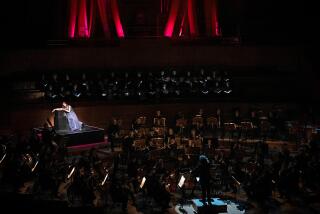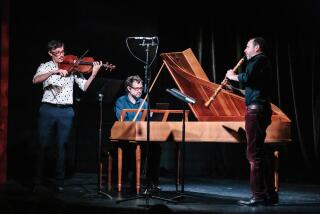When opposites attract
- Share via
When Antonin Dvorak came to the United States at the end of the 19th century, he was determined to show the fledgling American classical music community a thing or two about itself. Write music using American source material, he insisted, and that includes the spiritual and the music of Native Americans. He furthermore advocated opening up the mainly white male ranks to more women and African Americans.
Be yourself, Dvorak said, just do so in my language. Clothe your American tunes in European -- that is, Brahmsian or, better still, Dvorakian -- symphonies. Give the New World a “fresh” Old World character.
But it is not so simple anymore in a multicultural world. Dvorak was on the bill for the Southwest Chamber Music program at the Huntington Library Saturday night. So too was Joan Huang, a composer who was born in China in 1957 and immigrated to America 19 years ago. Two of her works for violin and percussion were sandwiched between two big Dvorak chamber pieces for strings from around 1875.
It was a lovely, warm evening, and the Huntington is a wonderful place for Southwest’s summer series, which takes place on the loggia of the Art Gallery. This is intimate chamber music without a chamber. (There are also lawn seats -- on one of the better lawns in America.)
The Huntington is well suited for Dvorak; Arabella Huntington was a patron of the Czech composer. And his robust string music is in the same style as these lush surroundings. But Huang, who lives in Altadena, was the local composer Saturday. And many Chinese are now San Marino neighbors of the Huntington.
Huang’s “The Legend of Chang-e” and “The Road of T’ao” were written for the Boston violin and percussion duo Marimolin in the mid-’90s, and they were here played by Shalini Vijayan, a vibrant violinist, and Lynn Vartan, an efficient percussionist.
Both works follow the opposite of Dvorak’s procedures. Huang expresses her native music and concepts in a foreign, Western language. “Chang-e” describes the Chinese legend of a beautiful moon goddess and her heroic husband, trapped by the sun.
Day turned to night during this performance. Day had already given us a burning sun and the sultry evening was to present a mysteriously glowing moon. The music accompaniment to this transition was magical. Huang writes rapturously for violin with agitated bowing softening to sweet pentatonic scales. There is drama to each phrase, yet also a sense of oneness with the material. The accompanying marimba took a while to reach the violin’s wavelength but did so as it followed the violin’s harmonics on their ethereal ascent into the ether.
“The Road of T’ao” is harder work for the listener and certainly for the percussionist, who this time needs a battery of instruments, from vibes to bongos. Interestingly, Huang says in her notes that she takes her sense of the Tao from a Westerner, Alan Watts. Though the root of her culture, Taoism was discouraged during the Cultural Revolution of her youth.
The music reveals these conflicts, or at least the performance did. Again there is much compelling violin writing, but the percussion often seemed at odds. Perhaps Vartan tried too hard. But the violin was heard, and by the end its spirit once more soared.
The Dvorak -- a trio for two violins and viola in the first part of the concert, the well-known and robust Quintet in G Major for Strings, Opus 77 after intermission -- was comfort music. The first violinist, Lorenz Gamma, gave the works a more strident edge than might have been wished, but these were softened by the more flowing second violin of Vijayan in both pieces and the ingratiating lyricism of the cellist Sebastian Toettcher in the quintet. Jan Karlin was violist in both works; Tom Peters, the rock-solid bassist.
Southwest Chamber Music has had its ups and downs, performance-wise, over its 18 seasons. But it has always programmed creatively and internationally, and it is, in every way, more up than down these days.
It has won two Grammys in a row for CDs of the music of Carlos Chavez, but the just-released third volume is the best yet.
And let’s hear it for the Huntington. At least one local museum still recognizes the value of sophisticated, timely chamber music.
More to Read
The biggest entertainment stories
Get our big stories about Hollywood, film, television, music, arts, culture and more right in your inbox as soon as they publish.
You may occasionally receive promotional content from the Los Angeles Times.











